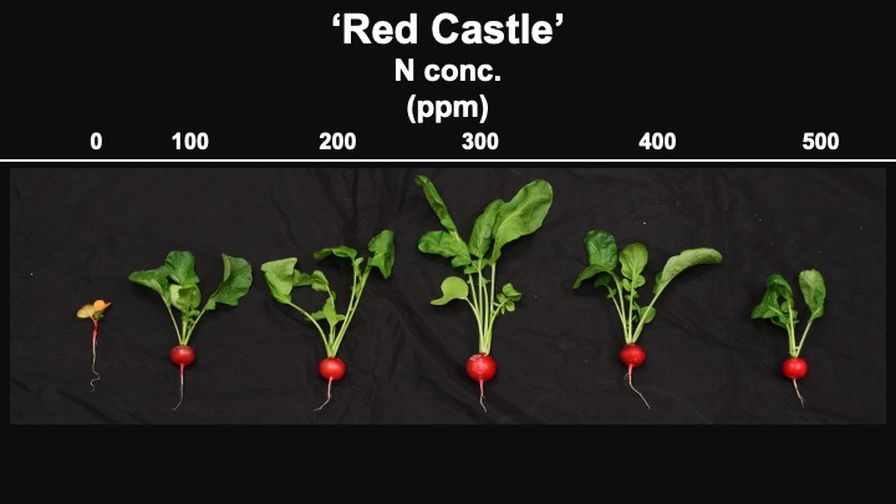How Mineral Nutrition Impacts Indoor-Grown Radishes

The ‘Red Castle’ cultivar also had the largest diameter between 200 and 300 ppm N. When the fertilizer concentration increased above 300 ppm N, the radishes were smaller. Graphic: Christopher Currey
Editor’s note: This is part two of a four-part series on hydroponic radish production. Read part one here.
While spring radishes are traditionally a field-grown crop, their short production time, high planting density, and performance in cool air temperatures make them an attractive candidate for controlled-environment agriculture. In our first article, we covered the importance of cultivar selection and highlighted some radish cultivars with good greenhouse performance. However, cultivar selection is only one piece of the production puzzle.
Managing mineral nutrition is important for food crop production, whether in mineral field soilless, soilless substrates, or in hydroponic water culture. Providing adequate mineral nutrient to plants helps realize their yield potential, in addition to keeping fruits and foliage free of deficiency or toxicity symptoms, and helps maximize their appearance and marketability. In trying to determine how to fertilize radishes grown hydroponically, in trays with soilless substrate and subirrigation, we couldn’t successfully translate the recommendations for field-grown radishes in pounds of nitrogen per acre to parts-per-million (ppm) nitrogen in a soilless system in a greenhouse. As such, we designed a study to determine what concentration of fertilizer would be appropriate for growing radishes in a controlled environment.
Materials and Methods
Based on previous research, ‘Crunchy King’ and ‘Red Castle’ were selected based on their performance in cultivar trials. Seeds were sown in 72-cell plug trays filled with a commercial soilless substrate and covered with a light covering of coarse vermiculite. After seeding, trays were moved into a glass-glazed greenhouse with a constant air temperature setpoint of 68°F and a target daily light integral of 12 mol∙m–2∙d–1.
Seeded trays were placed into one of six identical flood tables, with interior dimensions measuring 36 inches W × 72 inches L × 7.4 inches H. Trays were initially hand-irrigated to saturation with clear water immediately after planting. Flood tables were flooded every morning for the first two weeks, and in the morning and afternoon in the third and fourth week. Each of the different flood trays had their own 40-gallon reservoir filled with a solution consisting of tap water amended with 15-5-15 Cal-Mag (Peters Excel; ICL Specialty Fertilizers, St. Louis, MO) to provide one of six fertilizer concentrations: 0, 100, 200, 300, 400, or 500 ppm nitrogen (with corresponding ECs of 0.00, 0.76, 1.52, 2.28, 3.04, or 3.80 mS/cm, respectively).
Four weeks after seeds were sown, data were collected. The diameter and fresh weight of trimmed and washed radishes were recorded, and additional radishes were graded by hypocotyl diameter according to USDA grading standards. Additionally, leaf number, length, and greenness were recorded prior to trimming, to account for producers selling radishes with foliage in bunches.
Effects of Fertilizer Concentrations
At the end of 28 days, we could see clear effects of the fertilizer concentration on the growth of ‘Crunchy King’ and ‘Red Castle’ radishes. For both cultivars, the diameter of radishes increased and were largest between 200 and 300 ppm N (1.52 to 2.28 mS/cm); as fertilizer concentration increased above 300 ppm N, the radishes were smaller. Additionally, the variability in USDA grades of trimmed radishes increased as fertilizer concentration increased above 300 ppm N. We saw very similar results with the fresh weight of trimmed radishes, and yield was greatest at 200 to 300 ppm N. Although plants that were not provided with any fertilizer had fewer and smaller leaves than radishes receiving 100 to 500 ppm N, there were no differences in the number, size, or greenness of radishes receiving fertilizer.
Putting Science Into Practice
There are a few considerations when determining how to fertilize your radishes. First, we used a classic 15-5-15 Cal-Mag fertilizer — and that was by design. Most commercial greenhouse fertilizers are a combination of ammoniacal forms nitrogen including ammonium (NH4+) and urea (which is converted to ammonium and “counts” as ammonium) and nitrate (NO3-) nitrogen. We selected 15-5-15 because of the higher proportion of nitrate than other fertilizers. The majority of ammonium is converted into nitrate for plant uptake, and nitrifying bacteria get this done. However, at cooler growing temperatures the activity of nitrifying bacteria slows down, which can lead to excessive ammonium and — in some cases — ammonium toxicity.
Also called “dark weather feed,” the higher proportion of nitrate in the 15-5-15 Cal-Mag makes it well-suited to cooler growing temperatures, in which radishes can grow. We certainly encourage producers to try other fertilizers for soilless radish production, but we suggest evaluating your growing temperatures and match that with the appropriate ammonium:nitrate ratio. Those growers using warmer temperatures can use fertilizers with a higher proportion of ammonium, whereas those growing at similar or cooler
temperatures should look at other high-nitrate formulations.
The electrical conductivity (EC) of the different nutrient solutions stayed consistent throughout the experiment. Managing the nutrient concentration in ebb-and-flood systems is different than continually circulating water culture systems like nutrient film technique (NFT) or raceway or deep flow technique (DFT). However, we used freshly made nutrient solutions each time the experiment was repeated. In commercial practice, we would use the fertilizer solution for a longer period. While the fluctuation in ebb-and-flood reservoirs may not be as great as in hydroponic water-culture systems, don’t simply monitor the EC and pH of your nutrient solution. Instead, perform periodic laboratory analyses so you know the concentration of different nutrients and know when to start replacing old solution with new solution to avoid nutrient imbalances from occurring.
Key Takeaways
Based on our research, we feel commercial producers interested in growing radishes in soilless culture with ebb-and-flood systems should try using fertilizer concentrations providing 200 to 300 ppm N (plus the other macro- and micronutrients). The unique combinations of cultivars, environmental conditions, and other cultural practices warrant that trials should be conducted to see how these recommendations will work in your facility.










